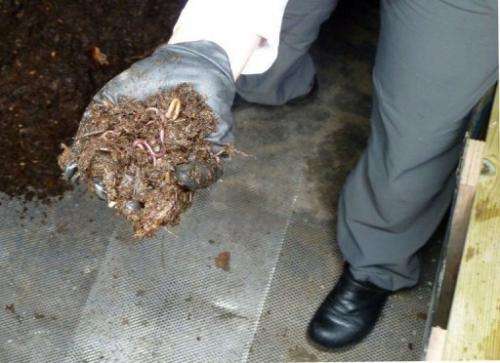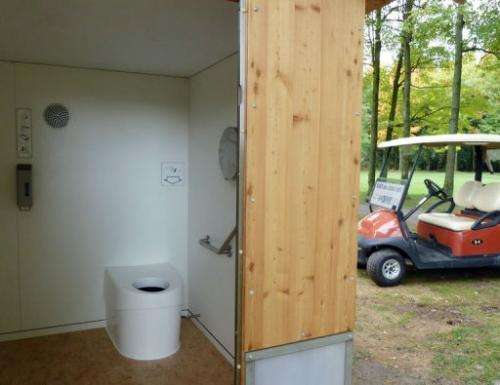Turd-eating worms clear air around Canadian toilets

Anyone relying on their nose to guide them to a toilet at Quebec's La Providence golf course won't find one—that's because its outhouse is odorless.
Beneath a tidy wooden latrine on the grounds is an army of earthworms that churn decaying organic materials into compost.
The worm-powered design is a first of its kind in North America, according to Ecosphere Technologies international sales representative Frederic Neau. It was developed near Nyons, France.
A half-kilogram (1.1 pounds) of Eisenia fetida or red wiggler worms native to Europe imported from France and raised locally by Helene Beaumont are placed between layers of dung and straw in an underground space beneath the toilet.
"A worm eats almost its own weight in food each day," she told AFP during a demonstration at the golf course in Saint-Hyacinthe east of Montreal. "And the more poop there is to eat, the more they reproduce."
The washroom uses neither water nor electricity, and can be used 10,000 times before needing maintenance.

A pedal at the foot of the toilet triggers a system of conveyor belts that separate fecal matter from urine, which is then filtered through sand while the stool goes to the worms.
Urine mixed with feces is what produces the typical unpleasant odors in some older dry toilets, said Neau.
A venting system in Ecosphere's washroom also flows air away from the washroom to doubly ensure it produces no bad smells.
Neau pointed to dozens of installations in France, Spain, Switzerland and Italy as proof of concept, where electricity or water may not be available, in mountain retreats or nature parks.
Canada's vast wilderness dotted with hundreds of thousands of remote cabins and campgrounds, ski lodges and hunting camps, as well as sugar shacks makes it an ideal market for this technology.
Several varieties of dry composting toilets can already be found throughout the country, mostly in privately-owned vacation cabins in the woods.
In most of these, excrement is mixed with a scoop of sawdust, coconut coir or peat moss to support aerobic processing, absorb liquids and reduce odors.
The decomposition process is generally faster than in wet sewage treatment systems such as septic tanks.
Ecosphere's toilets are not cheap at Can$40,000 (US$40,800) each, compared to competitors that charge an average of Can$1,800. But Neau said the price will likely drop as sales increase.
Maintenance costs, he added, are negligible since the facilities only require a check on the worms once per year, while other dry composting toilets often need far more maintenance and output management.
(c) 2012 AFP

















